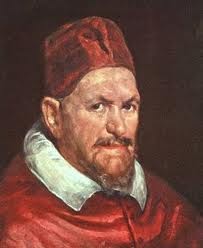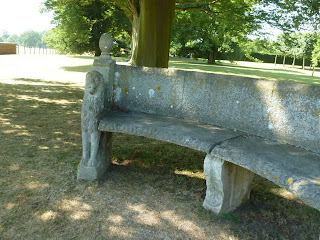I had already planned to include Norfolk on my summer visit to England when I chanced upon the Vanity Fair magazine of May, 2013, describing the successful efforts of the Marquess of Cholmondeley to return the paintings collected by his ancestor Sir Robert Walpole to Houghton Hall for an exhibition (click here for the article). I literally salivated at the thought!
Click here to visit the website. Everything about this event appealed to me -- the opportunity to see the Hall and its grounds, the glorious paintings to be seen, the fascinating story of Sir Robert Walpole and his career as England's first Prime Minister in the reign of George I, and the equally interesting story of how his great collection of Old Masters was sold to Catherine the Great and subsequently a few of them re-sold by Stalin's government to western museums, leaving most of them in the Hermitage and other Russian venues.
A work by Paris Boldone (1500-1571),
variously titled Two Women and a Soldier or
Venus, Flora, Mars and Cupid (Allegory), c. 1550
State Museum The Hermitage, St. Petersburg
Ed and I left Cambridge by train on another sunny, warm morning in July and arrived a bit over an hour later at King's Lynn, a charming town I am sorry we had no time to explore. In lieu of renting a car someplace along our route, we had decided to travel by taxi. We'd left most of our gear in London, but had along a suitcase and a big computer bag. Therein, the dilemma. What to do with the bags while we toured Houghton?
Houghton Hall, July, 2013
Going first to our hotel at Holkham was considerably out of the way and would add time and many £££s to our trip. Our taxi driver offered us an alternative. We could leave our bags with him and he would return to meet us in the late afternoon and drive us to Holkham. Well, we'd be in very deep trouble if our bags disappeared, wouldn't we? Ed and looked at each other, eyed the driver who seemed like a hearty Norfolk fellow, entirely trustworthy, and so we thanked him profusely and accepted his kind offer. After all, it was England where everyone is honest -- we hoped! We set a rendezvous time -- late in the afternoon so we could see everything!
We had plenty of time before our timed tickets were scheduled, so we wandered the gardens and had lunch in the convenient teashop. Lots of spots for Ed to take the weight off his foot. More about the gardens in the next post. I will skip ahead to entering the Hall itself, approaching through a cool grove of trees.
Coming in to the ground floor and surrendering our tickets, we realized the crowds were large, and seating would probably be at a premium. We were right
.
Borghese Gladiator, in the Great Staircase
We began with the great staircase, which dimly turns around a magnificent life-size bronze sculpture of a gladiator.
Sir Robert Walpole
workshop of Van Loo
Houghton Hall was built by Sir Robert Walpole (1676-1745), Britain’s first and longest-serving Prime Minister, later the 1st Earl of Orford. Over the many years of his power during the reigns of George I and George II, Walpole purchased a superb collection of Old Master paintings with which he filled the walls of his magnificent country house. The splendor of house itself and its outstanding contents – paintings, tapestries, sculpture, furniture, even china, were part of Walpole’s technique of acquiring and maintaining political and cultural power among the peers of the realm.
The Stone Hall
Walpole’s grandson, the 3rd Earl of Orford, sold a large portion of the great collection in 1779 to Catherine the Great, ruler of Russia, to pay off accumulated family debts. At the time, as well as today, it was considered a great loss for the British people, and it was one of the situations which led to the creation of the National Gallery, now presiding majestically over Trafalgar Square in London. At last, there was a non-royal venue for depositing the finest art of British collections.
The Stone Hall, ©Vanity Fair
Houghton's Stone Hall displays a collection of marble busts, some from ancient sources, others of Walpole himself and his colleagues. The startling white of the Stone Hall is one of those abrupt changes in atmosphere that country house designers like, a complete change of atmosphere from subdued lighting to brilliance.
The Saloon
Built in the 1720’s, Houghton Hall results from the combined efforts of architects James Gibbs and Colen Campbell, in the Palladian style, somewhat imbued with the baroque. William Kent designed the interior décor and furniture. The current resident of Houghton Hall is the family of the 7th Marquess of Cholmondeley (pronounced Chumley), a descendant of Walpole’s daughter Mary, who became the wife of the 3rdEarl of Cholmondeley in 1723. David Cholmondeley (b. 1960) serves as the Lord Great Chamberlain of the U.K. and is seen every year leading the Queen to the State Opening of Parliament.
In 2007, Queen Elizabeth II and the Lord Great Chamberlain,
the 7th Marquess of Cholmondeley
The Marquess reportedly discovered an original plan of hanging the collection, so the paintings from the Hermitage have been hung much as they originally were when Walpole lived at Houghton Hall. The collection includes works by Rembrandt, Rubens, and Van Dyck as well as Poussin, Velazquez, and Murillo.
The Maratta Room
A whole room of the exhibition is given over to the work of Carlo Maratta. Most well known of his works might be the portrait below of Pope Clement IX.
Carlo Maratta, Portrait of Pope Clement IX, 1669
The Maratta portrait contrasts interestingly with the Portrait of Pope Innocent X, by Velazquez (1599-1660) which usually hangs in the National Gallery in Washington, D.C
Velazquez, Portrait of Pope Innocent X, 1599-1600, NGA
A second National Gallery painting in the exhibition is Franz Hals (1581-1666) Portrait of a Young Man. These two paintings were sold by the USSR to Andrew Mellon, who gave them to the NGA.
Frans Hals, Portrait of a Young Man, 1646/48, NGA
Green Velvet Bedchamber
Frankly, the splendor is far more than one can comprehend in a single visit. I spoke with one lady who was there for the second time and she planned to return at least once more. If only I’d had that opportunity! Not only are the paintings worth long contemplation; the house itself, the furnishings and décor are stunning. I was so entranced by the whole scene that I forgot about Ed and his throbbing foot, but he managed to negotiate the crowds and dim light, even snagging a chair now and then (hopefully only those reserved for the guides and not one of the William Kent originals).
Embroidered Bedchamber
Not only the paintings but all the furnishings, the tapestries, the molded ceilings, every inch of Houghton Hall is worth contemplating. I valiantly tried to keep it all in my head, but I probably missed a great deal of it. An abundance of riches indeed.
Portrait of Sir Thomas Wharton (detail)
by Anthony Van Dyck, 1639
State Hermitage Museum, St. Petersburg
The Exhibition has been extended to 24 November 2013. I lingered as long as I could in each room but the press of the crowds required pretty constant movement. I will spend many more hours looking at the catalogue and enjoying the memories. I found Ed outside enjoying the breezes, as the house had been quite warm.
He found a shady bench where we sat and simply tried to absorb what we'd seen. Astonishing. Overwhelming. And we still had some of the garden to visit too. More about that coming soon.



























No comments:
Post a Comment